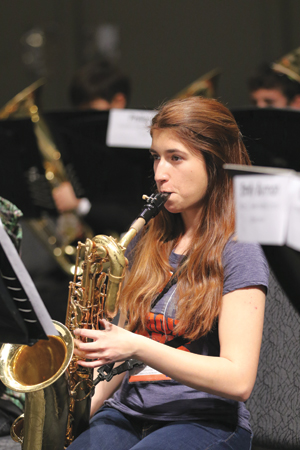 Starting notes in the low register is a common concern on the saxophone. Many younger students have problems beginning notes in the lowest range of the instrument, even at fairly comfortable dynamics. For some, this difficulty can begin as high as written F4. Several factors can contribute to this problem, but with a bit of knowledge and some work on the part of the student, it is easily fixed.
Starting notes in the low register is a common concern on the saxophone. Many younger students have problems beginning notes in the lowest range of the instrument, even at fairly comfortable dynamics. For some, this difficulty can begin as high as written F4. Several factors can contribute to this problem, but with a bit of knowledge and some work on the part of the student, it is easily fixed.
Check the Instrument
First, check the student’s equipment to make sure that it is appropriate to the task and in functional condition. A damaged mouthpiece or leaking instrument can make low range playing difficult or impossible for even professional saxophonists. In addition, a reed that is too soft or hard, damaged, or worn out can cause many problems. A moderate mouthpiece with a medium-strength reed, a high-quality ligature, and a functional saxophone are all essential.
Next, make sure that the student’s mouthpiece is not pulled out excessively. Most saxophones are designed to perform correctly when the mouthpiece is pushed fairly far onto the cork. If pulled too far out, not only will intonation suffer, but the response of both the lowest and highest ranges will be thrown off greatly.
Resist Change
An innocuous suggestion to help many young saxophonists in the low range has actually caused most of the anguish surrounding this range of the saxophone. The instruction “drop your jaw” will make it virtually impossible to play in the instrument’s lower depths. Instead, young players should fight every temptation to change their embouchure. At every range of the saxophone, the best course is no change at all, whether in the lips, jaw, or airstream. For every note of the saxophone, the student should focus on breathing low in the abdomen and allowing all air to flow out of the bell.
Another piece of advice along this line is that soft dynamics in the low range of the saxophone should not be emphasized too early. The first attempts at performing and articulating in the lower range should be attempted at fairly strong dynamics so that proper air support can be achieved. Once students are comfortable, they can transfer these new skills to softer dynamic levels.
Flicking
One technique can make performing lower pitches a bit easier once the above is kept in mind. The lower the note, generally speaking, the longer the air column in the saxophone that must be activated. This contributes to the difficulties in starting low notes.
The flick technique is used by many saxophonists on initial articulations in the lower register to ease performance. When playing an F4 or below, the saxophonist should raise the first finger in either the right or left hand. At the split second before initiating the attack, the open finger should be closed, helping the airstream to begin vibrating. This may take a bit of work to avoid out-of-sync finger closing, but ultimately, it will help the performance of lower notes.
For Advanced Players
A final word should be mentioned about a small trick that can be used only once the performer is comfortable with lower pitches. The saxophone is sometimes called upon in both solo and wind ensemble literature to begin passages very softly in the lowest reaches of the instrument. Once all of the above has been fully developed, the saxophonist can aid soft attacks by pulling up slightly into the reed with the lower lip. This will dampen the vibrations of the reed, causing a more easily controlled attack. This is the only time that I ever advocate any change in saxophonist embouchure at all.
These pointers will help young saxophonists with a skill that often seems difficult. Once the lower range is mastered, saxophonists will be one step closer to having complete control of their instrument.






